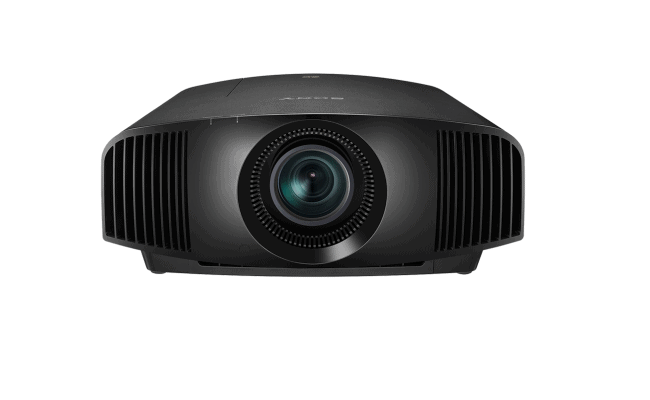Table of Contents
amazon Sony VPL-VW325ES reviews
Image quality is like a Porsche emerging from the Volkswagen lineup.
With a price tag of up to $ 5,500, the VPL-VW325ES projector model (VPL-VW290ES in some markets) is still only classified in the low-cost segment in Sony’s 4K HDR home cinema product range. Even so, its quality is still very respectable, thanks to the excellent contrast. It is 5-6 times more expensive than many other projector models, but the picture is also much better.
Overview
The technology feature of Sony projectors is SXRD (actually LCoS – Liquid Crystal on Silicon). Sony uses three chips with 4K DCI resolution to create extremely high contrast, the biggest determinant of projector image quality. The contrast of the product is ten times higher than most projectors I have reviewed – of course; many also cost less.
Thanks to the impressive contrast, the image it produces is very real and vivid, with a depth that no cheaper product can match. Of course, nothing is perfect, and Sony projectors still have their weaknesses. The opposite of the extremely high contrast is the low brightness, only 1,500 lumens.
Compared to today’s standards, when many projectors have provided up to 2,500 lumens, even a few reach 3,000 (of course, it can be even higher if you spend more money), that number is an unfortunate minus point. However, darker doesn’t mean worse, the VW325ES resembles an OLED TV, with low brightness but high contrast, and the picture is still very good.
Configuration
Resolution: 4K DCI (4,096 x 2,160 pixels).
Size: 60 – 300 inches.
Brightness: 1,500 lumens.
Magnification: x2.06.
Light source: 225W lamp.
This projector model offers native 4K DCI resolution instead of 4K UHD or 4K pixel shift like many other cheaper products.
Another point that makes Sony products outstandingly expensive is the proprietary SXRD display chip. Most projectors from other brands will use DLP chips manufactured by Texas Instruments, or like Epson, use LCD chips (3LCD projection technology).
They chose LCoS projection technology and built their chips with 4,096 x 2,160 pixels for Sony. They are more expensive and more advanced, found only on Sony or JVC projectors (their LCoS version is called “D-ILA”). LCoS will have the highest contrast.
Sony does not specify projector lamp life, and this is a problem. An older and more expensive model I’m using has degraded significantly after about 3,000 hours of screen time. Assuming you watch 4 hours a day, you will have to change the bulb every two years.
Image quality
Try putting the VW325ES next to two cheaper projector models from Epson and LG; we will have a more accurate view of the display quality of a product worth $ 5,500. The Epson Home Cinema 5050UB model costs $3,000; the LG HU810P is about the same. Is paying nearly double the price for a Sony product a worthy decision?
Although the brightness on the Sony projector is significantly lower in theory than the two cheaper products, the results are quite contradictory. My eyes seem to sink into it. Compared to the Epson, the blacks from the Sony projector are deeper, and bright details are also more pronounced. That makes the image more realistic. The lower the light conditions, the deeper the blacks stand out.
Epson’s picture isn’t bad, but the Sony is still marginally better. In a word, OLED TVs have been winning live competitions for several years now. And LCoS technology on Sony products is an OLED version in the projector world. Outstanding contrast is a “trump card” for it to beat the competition even when it is inferior in brightness.
Next is the detail, and surprisingly, Sony is also marginally better than Epson and far behind the LG HU810P. When you pay close attention to details like the hairs and wrinkles on a character’s face, the Sony delivers a sharper 4K image than the other two. Part of that is thanks to the specialized hardware that Sony designed.
The processor chip is similar to its high-end TV models, providing better HDR image processing than many other projector models. One of the common problems with projectors is that handling HDR is difficult due to limitations in brightness or contrast. However, the Sony VW325ES can fully reproduce the HDR signal and produce images with very little artifact, which is easy for me to spot on lower projectors.
However, that does not mean that it completely overwhelms the opponent. Colors on Sony projectors are very accurate and true with non-HDR signal sources, but it does not have the depth and volume of volumes like LG and Epson if it is HDR. The VW325ES colors well and outperforms the other two for most content, but HDR alone isn’t as impressive.
Conclude
This projector offers the closest movie theater experience to any other product I’ve reviewed recently. However, 5,500 USD is not a small number; we can do many things with that much money. Or you can buy an Epson 5050 with excellent image quality and still have up to $2,500 leftover.
And if you’re willing to spend that money, this must be the Porsche in the projector world; it’s really good. The VW325ES in Reference mode provides 126 nits of brightness, worse than the Epson 5050 when it can reach 192 nits. In return, contrast is an outstanding advantage. The Epson 5050 only offers 5.203:1, while the Sony is 9,014:1. You must choose to trade-off brightness or contrast to make the right choice.
Advantages:
Amazing photo.
Great contrast.
Quiet operation.
Defect:
Expensive.
Low brightness.
Color is not good.
where can you get a Sony VPL-VW325ES online
Sony VW325ES 4K HDR Home Theater Projector VPL-VW325ES, Black: Buy it now
sony vpl-vw325es australia vpl-vw325es-b contrast ratio release date manual price review vs jvc nx5 3d 4k projector
